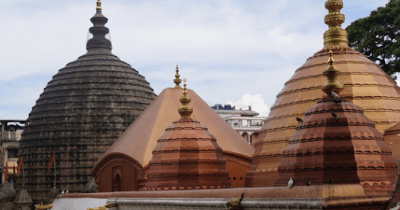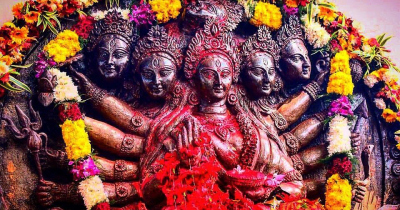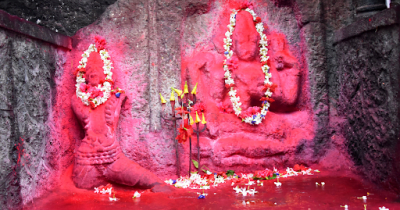Kamakhya mandir
The Kamakhya Mandir: A Testament to Hindu Tradition and Devotion

The Kamakhya Mandir, situated on the Nilachal Hill in Guwahati, Assam, stands as a testament to the rich Hindu mythology and deep devotion that permeate the area. Dedicated to the formidable deity Kamakhya Devi, this ancient shrine holds immense significance for worshippers and scholars alike, attracting devotees from all corners of the globe to its hallowed precincts.
Historical Background
The genesis of the Kamakhya Temple is steeped in the mythological narratives of Hinduism, intertwining the exploits of gods, demons, and cosmic powers. According to Hindu scriptures, the saga begins with the creation of the universe, wherein goddess Sati, consort of Lord Shiva, immolated herself during a ritual conducted by her father Daksha. These sites came to be known as Shakti Peethas, each associated with a specific part of Sati's body.
Legend has it that the Kamakhya Temple enshrines the yoni, symbolizing the reproductive organ of goddess Sati, making it one of India's revered Shakti Peethas. The name "Kamakhya" derives from the Sanskrit word "Kama," signifying desires or aspirations, underscoring the deity's connection to fertility, desires, and feminine power. Over the centuries, numerous rulers and devotees have embellished the temple's splendor, perpetuating its spiritual legacy from the ancient Kamarupa kingdom to the Ahom dynasty, thus making Kamakhya Mandir a bastion of faith and cultural patronage throughout history.
Architectural Features
The architectural opulence of Kamakhya Mandir bears testimony to the amalgamation of diverse influences, blending indigenous Assamese styles with elements borrowed from neighboring regions. Dominating the temple complex is the main edifice, distinguished by its iconic dome and four spires, epitomizing Assam's architectural finesse. Crafted predominantly from stone and brick, the temple ensemble comprises multiple chambers, corridors, and courtyards adorned with intricate carvings and sculptures depicting Hindu deities and mythological motifs.
A highlight of Kamakhya Mandir is the garbhagriha, housing the sacred yoni symbolizing the divine presence of goddess Kamakhya. Pilgrims ascend a flight of stairs to reach the inner sanctum, where they offer prayers and rituals to invoke the blessings of the goddess. The sanctum exudes grandeur with its ornate carvings and embellishments, fostering an ambiance of veneration and spirituality.
Adjacent to the main temple are smaller shrines dedicated to various deities, including Lord Shiva, Lord Vishnu, and the ten Mahavidyas, showcasing intricate sculptures and reliefs narrating episodes from Hindu mythology. The temple's architectural magnificence is further accentuated by its natural surroundings, offering panoramic vistas of the Brahmaputra River and the verdant Nilachal Hill, thereby enhancing its mystical allure. As a symbol of enduring heritage, Kamakhya Mandir continues to evoke reverence and admiration among pilgrims and visitors, serving as a timeless emblem of faith and devotion in the heart of Assam.

Religious Significance
Kamakhya Mandir holds profound religious significance in Hinduism, particularly within the Shakta tradition, which venerates the divine feminine aspect of the universe. As one of the most prominent Shakti Peethas, the temple is revered as a source of primal energy and creative power, symbolized by the goddess Kamakhya. Devotees believe that worshiping at Kamakhya Mandir can bestow blessings of fertility, prosperity, and spiritual fulfillment.
Central to the temple's mythology is the belief in the presence of the goddess Kamakhya's yoni (reproductive organ) within the garbhagriha. This sacred symbol is worshiped as a manifestation of the divine feminine principle, representing the creative force of the universe. Rituals and offerings are conducted by priests and devotees to honor the goddess and seek her blessings for various aspects of life, including marital harmony, childbirth, and success in endeavors.
The annual Ambubachi Mela, held during the monsoon season, is one of the most significant festivals observed at Kamakhya Mandir. During this auspicious occasion, devotees gather in large numbers to celebrate the menstruation of the goddess Kamakhya, symbolizing her fertility and rejuvenation. The temple complex buzzes with fervent prayers, devotional songs, and colorful rituals, creating a vibrant atmosphere of spiritual fervor and cultural celebration.
Apart from the Ambubachi Mela, Kamakhya Mandir hosts several other festivals throughout the year, each commemorating significant events in Hindu mythology or local traditions. These festivals attract pilgrims and tourists from far and wide, who throng the temple premises to partake in the festivities and seek divine blessings. The observance of these festivals not only strengthens the religious fabric of the community but also serves as a platform for cultural exchange and social cohesion.

Beyond its religious significance, Kamakhya Mandir holds a special place in the hearts of devotees as a sacred pilgrimage site imbued with mystical energy and spiritual resonance. Many believe that a visit to the temple can lead to spiritual awakening and personal transformation, fostering a deeper connection with the divine and the self. The sanctity of Kamakhya Mandir transcends religious boundaries, welcoming people of all faiths and backgrounds to experience its divine aura and imbibe its timeless wisdom.
Cultural and Social Impact
The influence of Kamakhya Mandir extends far beyond its religious significance, permeating the cultural landscape of Assam and the wider Indian subcontinent. The temple serves as a cultural hub where traditional arts, music, and rituals converge, enriching the collective heritage of the region. Throughout history, Kamakhya Mandir has been patronized by rulers, poets, and scholars who recognized its cultural significance and contributed to its preservation and embellishment.
The temple's annual festivals and rituals play a crucial role in fostering social cohesion and communal harmony among diverse communities. People from various walks of life come together to participate in the festivities, transcending caste, creed, and socio-economic barriers. This spirit of inclusivity and unity reflects the ethos of Kamakhya Mandir as a sacred space where all are welcome to seek solace, guidance, and blessings from the divine.

Moreover, Kamakhya Mandir serves as a major pilgrimage destination and tourist attraction, generating economic opportunities for the local community. The influx of pilgrims and tourists sustains a vibrant ecosystem of hospitality, commerce, and cultural exchange, contributing to the socio-economic development of the region. Artisans, vendors, and service providers thrive during festivals and peak tourist seasons, showcasing their craftsmanship and entrepreneurial spirit to a global audience.
In essence, Kamakhya Mandir embodies the symbiotic relationship between religion, culture, and society, serving as a beacon of spiritual enlightenment, cultural heritage, and social cohesion. Its enduring legacy continues to inspire generations of devotees and visitors, reaffirming the timeless values of faith, tradition, and community that resonate across the Indian subcontinent and beyond.
Festivals and Celebrations
Kamakhya Mandir is renowned for its vibrant festivals and celebrations, which attract pilgrims and tourists from far and wide, adding to the temple's aura of spirituality and cultural richness. Among the most significant festivals observed at the temple is the Ambubachi Mela, held annually during the monsoon season. This unique festival commemorates the menstruation of the goddess Kamakhya and is believed to symbolize her fertility and creative power. During the Ambubachi Mela, the temple complex buzzes with devotees and visitors who come to pay homage to the goddess and seek her blessings for fertility, prosperity, and spiritual fulfillment. The festival is marked by elaborate rituals, devotional songs, and cultural performances, creating a vibrant atmosphere of religious fervor and communal harmony.
Apart from the Ambubachi Mela, Kamakhya Mandir hosts several other festivals throughout the year, each dedicated to different deities and celestial beings. These festivals serve as occasions for religious observance, cultural expression, and social gathering, fostering a sense of community among devotees and visitors. Among the notable festivals celebrated at the temple are Durga Puja, Navratri, Diwali, and the annual Rath Yatra, which attracts devotees from various parts of India and beyond. Each festival has its unique rituals, traditions, and significance, reflecting the diverse tapestry of Hindu mythology and religious practices.
In addition to religious festivals, Kamakhya Mandir also hosts cultural events and programs that showcase the rich heritage of Assamese art, music, and dance. These cultural initiatives not only promote the artistic talents of the local community but also serve as platforms for cultural exchange and dialogue among people from different backgrounds. Through music concerts, dance performances, and art exhibitions, Kamakhya Mandir contributes to the preservation and promotion of Assamese culture, enriching the cultural fabric of the region and beyond.
Modern-Day Relevance
In the contemporary era, Kamakhya Mandir remains as relevant and revered as ever, serving as a beacon of spirituality, cultural heritage, and social harmony. Despite the challenges posed by modernization and urbanization, the temple continues to draw devotees and visitors from all walks of life, reaffirming its status as a sacred pilgrimage site and cultural landmark. The temple authorities, along with the local community, have undertaken initiatives to preserve and promote the heritage of Kamakhya Mandir, ensuring that its sanctity and significance endure for future generations.
Moreover, Kamakhya Mandir has embraced technology and innovation to enhance the visitor experience and facilitate religious practices. The temple complex is equipped with modern amenities such as visitor centers, information kiosks, and online booking facilities, making it easier for pilgrims and tourists to plan their visit and participate in rituals. Additionally, the temple has a strong online presence, with social media platforms and websites providing information about its history, festivals, and services, thereby reaching out to a wider audience and fostering global connectivity.
Despite these advancements, Kamakhya Mandir remains deeply rooted in tradition and spirituality, preserving age-old rituals and customs that have been passed down through generations. The temple's timeless teachings and practices continue to inspire devotees to seek inner peace, spiritual enlightenment, and divine blessings, transcending the boundaries of time and space. As a sacred pilgrimage site and cultural icon, Kamakhya Mandir stands as a testament to the enduring power of faith, tradition, and community, offering solace, guidance, and inspiration to all who seek its divine grace.

Visitor Experience
Visiting Kamakhya Mandir is an unforgettable experience that offers a blend of spiritual enrichment, cultural immersion, and natural beauty. As one of the most revered pilgrimage sites in India, the temple attracts devotees and tourists from across the country and around the world, each seeking a glimpse of its divine aura and blessings of the goddess Kamakhya. Here's what visitors can expect when they embark on a journey to this sacred sanctuary:
Upon arriving at Kamakhya Mandir, visitors are greeted by the majestic sight of the temple complex, perched atop the Nilachal Hill against the backdrop of the Brahmaputra River. The serene ambiance and panoramic views create a sense of tranquility and reverence, setting the stage for a spiritually uplifting experience.
As visitors ascend the stairs leading to the temple entrance, they are enveloped in the sounds of devotional chants and the fragrance of incense wafting through the air. The atmosphere is charged with anticipation and devotion as pilgrims prepare to offer prayers and seek blessings from the goddess Kamakhya.
Inside the temple complex, visitors are greeted by the sight of the main garbhagriha, where the sacred yoni symbolizing the goddess Kamakhya's divine presence is enshrined. Devotees queue up to perform rituals and offerings, guided by priests who facilitate the worship ceremonies with reverence and devotion.
Apart from the main temple, visitors can explore the various shrines and pavilions scattered across the temple complex, each dedicated to different deities and celestial beings. These sacred spaces offer moments of quiet reflection and spiritual contemplation, allowing visitors to connect with the divine energy that permeates the surroundings.
Throughout the year, Kamakhya Mandir hosts a myriad of festivals and celebrations, providing visitors with the opportunity to witness the temple come alive with color, music, and fervent devotion. From the Ambubachi Mela to Durga Puja and Navratri, each festival offers a unique glimpse into the rich tapestry of Hindu mythology and cultural traditions.
For those seeking a deeper understanding of the temple's history and significance, guided tours and informational sessions are available, providing insights into the architectural marvels, religious practices, and cultural heritage of Kamakhya Mandir. Visitors can also engage with local artisans and craftsmen, who showcase their traditional skills and craftsmanship through intricate sculptures, paintings, and handicrafts.
Before departing from Kamakhya Mandir, visitors are encouraged to partake in the prasad (blessed food) offered by the temple priests, symbolizing the goddess's blessings and divine grace. With hearts full of devotion and minds enlightened by spiritual wisdom, visitors bid farewell to the temple, carrying with them memories and blessings that will last a lifetime.
Conclusion
In conclusion, a visit to Kamakhya Mandir is not just a journey to a sacred shrine; it is an odyssey of the soul, an immersion into the timeless realm of faith, devotion, and divine grace. Whether seeking solace, seeking blessings, or simply marveling at the temple's architectural splendor, visitors are sure to find inspiration and enlightenment amidst the sanctity and serenity of Kamakhya Mandir.




